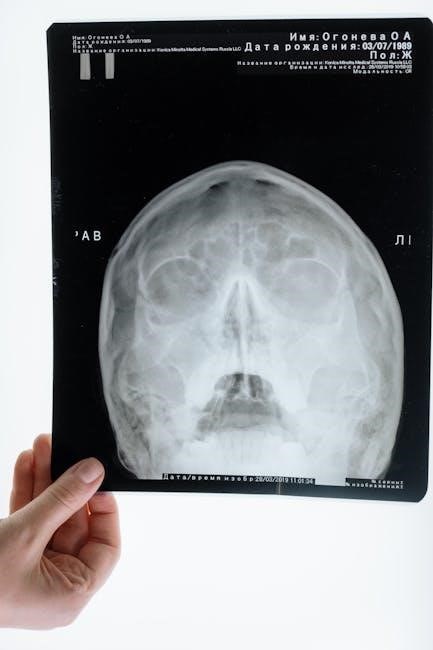written in bone pdf
1.1 What is Forensic Anthropology?
Forensic anthropology is the scientific study of human remains to aid legal investigations. It involves analyzing skeletal remains to determine age‚ gender‚ nationality‚ and cause of death‚ helping solve crimes and uncover historical secrets‚ as seen in Written in Bone.
Forensic anthropology is a scientific discipline that applies anthropological knowledge to legal and investigative contexts. It focuses on the analysis of human remains to aid in identifying individuals‚ determining the cause of death‚ and reconstructing life histories. This field combines biological anthropology‚ osteology‚ and archaeology to examine skeletal remains‚ soft tissue‚ and other biological evidence. Forensic anthropologists use methods such as osteometric analysis‚ skeletal trauma assessment‚ and isotopic studies to gather data about an individual’s age‚ gender‚ ancestry‚ and health conditions. In Written in Bone‚ forensic anthropology is showcased through real-life case studies‚ illustrating how experts uncover hidden stories from skeletal remains. The book highlights the meticulous process of transforming silent bones into vivid narratives‚ demonstrating the critical role of forensic anthropology in solving historical and contemporary mysteries. This discipline not only aids in criminal investigations but also bridges the gap between the past and present‚ offering insights into human history and culture.

1.2 The Role of Forensic Anthropology in Solving Crimes
Forensic anthropology plays a crucial role in solving crimes by providing critical insights into human remains. In Written in Bone‚ the discipline is depicted as a vital tool for investigators‚ helping to reconstruct identities and circumstances surrounding death. By analyzing skeletal remains‚ forensic anthropologists can determine age‚ gender‚ ancestry‚ and stature‚ which are essential for identifying victims. They also examine trauma patterns‚ such as fractures or gunshot wounds‚ to uncover how an individual died. This expertise often assists law enforcement in piecing together fragmented evidence‚ especially in cases where remains are decomposed or incomplete. The book highlights how forensic anthropology bridges the gap between science and justice‚ offering a voice to those who cannot speak for themselves. Through meticulous analysis‚ forensic anthropologists help solve mysteries that might otherwise remain unsolved‚ demonstrating their indispensable role in criminal investigations and the pursuit of truth.

Overview of “Written in Bone”
Written in Bone by Sally M. Walker is a non-fiction book that delves into forensic anthropology‚ blending science with historical storytelling. It explores how experts analyze skeletal remains to uncover identities and solve crimes‚ offering insights into the field’s methods and significance.
2.1 Author Background: Sally M. Walker
Sally M. Walker is a renowned American author and science writer‚ specializing in non-fiction books for young adults and general readers. Born in 1954‚ Walker developed a passion for science and history from an early age‚ which shaped her career as a writer. She holds a Ph.D. in a science-related field‚ equipping her with the expertise to craft engaging and accurate narratives about complex scientific topics.
Walker’s writing often bridges the gap between science and storytelling‚ making intricate concepts accessible to a broad audience. Her work in forensic anthropology is particularly notable‚ as she collaborates with experts to ensure the accuracy of her content. Written in Bone showcases her ability to weave historical and scientific elements into a compelling narrative. Walker’s contributions have earned her recognition in the field of science communication‚ making her a trusted voice for readers seeking to understand forensic anthropology and its applications.
2.2 Book Structure and Key Themes

Written in Bone: Buried Lives of Jamestown and Colonial Maryland by Sally M. Walker is structured to seamlessly blend history‚ science‚ and storytelling. The book is divided into well-organized chapters that explore the intersection of forensic anthropology and colonial history; Each chapter focuses on specific themes‚ such as the discovery of skeletal remains‚ the scientific methods used to analyze them‚ and the historical context of colonial life.
Key themes include the role of forensic anthropology in uncovering the past‚ the challenges faced by early colonists‚ and the ethical considerations of studying human remains. Walker emphasizes the importance of understanding the lives of ordinary people‚ often overlooked in historical accounts‚ by examining their bones and burial sites. The book also highlights the collaboration between archaeologists‚ anthropologists‚ and historians in reconstructing the past. Through vivid descriptions and detailed analysis‚ Walker makes the scientific process accessible while shedding light on the lives of colonial Americans. This structure ensures a comprehensive and engaging exploration of history and science.

Scientific Methods in the Book
The book explores advanced forensic techniques like skeletal analysis‚ bone measurement‚ and dental studies to determine age‚ sex‚ and ancestry. These methods provide insights into the lives and deaths of colonial-era individuals‚ linking science to history.
3.1 Analyzing Skeletal Remains
In “Written in Bone‚” the analysis of skeletal remains is a cornerstone of forensic anthropology. Scientists meticulously examine bones to uncover details about an individual’s life and death. This process involves assessing the skeleton for signs of trauma‚ disease‚ or other abnormalities that could provide clues about the person’s identity and circumstances of death. By measuring bone dimensions and studying their structure‚ experts can estimate factors like height‚ ancestry‚ and even gender. These analyses are crucial for piecing together historical narratives or solving criminal cases. The book highlights how skeletal remains serve as a bridge between the past and present‚ offering insights into the lives of those who came before us. Through detailed descriptions of these scientific methods‚ “Written in Bone” illustrates the meticulous work involved in reconstructing identities and stories from skeletal evidence‚ demonstrating the profound connection between science and history.
3.2 Determining Age‚ Gender‚ and Nationality
Determining age‚ gender‚ and nationality from skeletal remains is a critical aspect of forensic anthropology‚ as explored in “Written in Bone.” Age estimation often involves analyzing skeletal development‚ such as the fusion of ossification centers in younger individuals or the closure of cranial sutures in adults. Dentition wear and joint degeneration also provide clues about an individual’s age. Gender determination relies on anatomical differences‚ particularly in the pelvis and skull‚ with females typically having wider pelvic outlets and males exhibiting larger‚ more robust cranial features.
Nationality is more challenging to determine and often involves analyzing cranial measurements and cultural or historical context. For example‚ certain skeletal traits may correlate with specific ancestral groups. Additionally‚ isotopic analysis of bones can reveal geographic origins based on the chemical composition of the individual’s diet and environment. These methods‚ while not always definitive‚ provide valuable insights into an individual’s background‚ aiding historians and forensic experts alike. The book vividly illustrates how these techniques are applied to reconstruct identities and solve mysteries‚ blending science with storytelling.

Historical Context
“Written in Bone” delves into the historical context of colonial-era graveyards and archaeological sites‚ particularly Jamestown and Colonial Maryland‚ providing insights into the lives of early settlers through forensic anthropology. The book bridges the past and present‚ revealing how skeletal remains uncover historical narratives.
4.1 Colonial-Era Graveyards and Archaeological Sites
“Written in Bone” explores the historical context of colonial-era graveyards and archaeological sites‚ shedding light on the lives of early settlers. These sites‚ such as those in Jamestown and Colonial Maryland‚ serve as repositories of historical information‚ offering insights into the diets‚ health‚ and lifestyles of the colonists. The book highlights how forensic anthropology has been instrumental in analyzing skeletal remains found in these locations‚ uncovering stories of hardship‚ disease‚ and survival. By examining artifacts and skeletal remains‚ researchers have reconstructed the social and cultural dynamics of these communities. The colonial era was marked by challenges‚ and the bones of those who lived during this time reveal tales of adaptation and resilience. The integration of archaeological findings with historical records provides a more comprehensive understanding of this pivotal period in American history.
4.2 Jamestown and Colonial Maryland
“Written in Bone” delves into the historical significance of Jamestown and Colonial Maryland‚ focusing on how forensic anthropology has illuminated the lives of early American colonists. Jamestown‚ the first permanent English settlement‚ and Colonial Maryland provide rich archaeological material that has been analyzed to reconstruct the past. The skeletal remains from these areas reveal insights into the colonists’ diets‚ diseases‚ and mortality rates‚ painting a vivid picture of their challenging existence. For instance‚ forensic anthropologists have identified signs of malnutrition and infectious diseases‚ which were prevalent due to harsh living conditions. Additionally‚ the analysis of burial practices and artifacts offers a glimpse into the social and cultural dynamics of these early communities. The discoveries in Jamestown and Colonial Maryland highlight the resilience and struggles of the colonists‚ providing a human dimension to historical records. These findings underscore the importance of forensic anthropology in bridging the gap between the past and present‚ allowing us to better understand the foundation of American history.

Educational Impact
“Written in Bone” serves as a valuable educational tool‚ offering insights into forensic anthropology and history. It engages students with real-world applications‚ fostering a deeper understanding of science and its role in uncovering the past.
5.1 Use in Classroom Settings
The integration of “Written in Bone” into classroom settings has proven to be highly effective for teaching forensic anthropology‚ history‚ and science. The book’s narrative style‚ combined with its scientific depth‚ makes it accessible to students at various educational levels. Teachers often use the book to supplement curriculum in subjects like biology‚ history‚ and criminal justice‚ aligning it with educational standards. The PDF version of the book is particularly useful‚ as it allows easy distribution and access for students and educators alike.
The text encourages critical thinking and interdisciplinary learning‚ making it ideal for project-based assignments. For instance‚ students can analyze case studies from the book to understand how forensic methods are applied in real-world scenarios. Additionally‚ the book’s focus on historical contexts‚ such as colonial-era burials‚ helps students connect scientific concepts to broader societal and cultural themes. Educators praise the book for its ability to engage students and inspire interest in STEM fields‚ making it a valuable resource for modern classrooms.
5.2 Supplementary Resources and PDF Availability
The availability of “Written in Bone” in PDF format has made it easier for educators and students to access the book’s content. Supplementary resources‚ such as study guides‚ discussion questions‚ and activity worksheets‚ are often provided alongside the PDF version. These materials are designed to enhance the learning experience‚ helping students engage more deeply with the book’s themes and scientific concepts. Teachers can use these resources to create structured lesson plans or assign independent study projects.
The PDF format also allows for easy sharing and distribution in digital classrooms. Many educational institutions have incorporated the book into their curricula‚ and the supplementary resources have proven invaluable for fostering critical thinking and interdisciplinary learning. The availability of these materials ensures that students can fully explore the intersection of forensic anthropology‚ history‚ and science in a structured and engaging way. This accessibility has made “Written in Bone” a popular choice for educators seeking to enrich their students’ understanding of these subjects.

Modern Applications
Forensic anthropology‚ as explored in “Written in Bone”‚ remains vital in modern crime solving. Advances in DNA analysis and 3D reconstruction enhance skeletal examinations‚ aiding law enforcement and historians in uncovering identities and causes of death.
6.1 Forensic Anthropology Today
Forensic anthropology has evolved significantly since its early applications‚ becoming a cornerstone in modern criminal investigations. Today‚ forensic anthropologists employ advanced techniques such as DNA profiling‚ 3D reconstruction‚ and CT scans to analyze skeletal remains. These tools enable precise identification of individuals‚ determination of cause of death‚ and reconstruction of events surrounding a person’s demise. In cases where traditional methods like fingerprinting fail‚ forensic anthropology fills the gap‚ particularly in identifying remains from mass disasters or conflicts. The integration of digital technology has also enhanced the field‚ allowing for faster and more accurate analysis. For instance‚ 3D-printed models of bones can help recreate crime scenes‚ while isotopic analysis can trace a person’s origin or migration history. Additionally‚ forensic anthropologists collaborate with law enforcement‚ archaeologists‚ and geneticists to solve cold cases and uncover historical truths. The book “Written in Bone” highlights these modern applications‚ demonstrating how the field continues to bridge the gap between science and justice‚ making it indispensable in contemporary forensic science.

6.2 The Book’s Relevance to Current Practices
“Written in Bone” remains highly relevant to contemporary forensic anthropology practices‚ offering insights into the field’s evolution and modern methodologies. The book’s detailed exploration of skeletal analysis‚ decomposition processes‚ and historical contexts aligns with current investigative techniques. For instance‚ the use of isotopic analysis to determine an individual’s origin‚ as discussed in the book‚ is now a standard practice in identifying human remains. Additionally‚ the book’s emphasis on the importance of understanding historical burial practices resonates with modern forensic investigations‚ where such knowledge aids in reconstructing crime scenes and identifying victims.

The book also highlights the interdisciplinary nature of forensic anthropology‚ which is crucial today. By combining anthropology‚ archaeology‚ and forensic science‚ the book mirrors the collaborative approach used in modern casework. Its accessible storytelling makes complex scientific concepts understandable‚ making it a valuable resource for both professionals and students. Ultimately‚ “Written in Bone” serves as a bridge between historical and contemporary practices‚ demonstrating the enduring importance of forensic anthropology in solving crimes and uncovering the past.
7.1 Summary of Key Points
“Written in Bone” by Sally M. Walker masterfully blends forensic anthropology‚ history‚ and storytelling to explore the analysis of human remains. The book delves into the scientific methods used to examine skeletal remains‚ such as determining age‚ gender‚ and ancestry‚ which are critical in solving crimes and reconstructing historical narratives. It also highlights the historical context of colonial-era graveyards and archaeological sites‚ such as Jamestown and Colonial Maryland‚ providing a rich backdrop for understanding the field’s applications. The text emphasizes the educational value of the book‚ making it a valuable resource for classroom settings and supplementary learning materials. Moreover‚ it underscores the modern relevance of forensic anthropology‚ demonstrating how the techniques discussed in the book remain integral to contemporary practices. Overall‚ “Written in Bone” serves as a comprehensive and engaging exploration of forensic anthropology’s role in uncovering the past and aiding justice‚ making it a significant contribution to both education and the field itself.
7.2 Final Thoughts on the Book’s Contribution
“Written in Bone” stands out as a remarkable resource that bridges the gap between forensic anthropology and history‚ offering a compelling narrative that engages both scholars and general readers. Its ability to weave scientific methods with historical context makes it a unique contribution to the field. The book’s accessible language ensures that complex concepts are understandable‚ making it an invaluable tool for education and public awareness. By focusing on real-world applications and historical cases‚ it highlights the importance of forensic anthropology in solving mysteries of the past and present. The inclusion of colonial-era graveyards and sites like Jamestown adds depth‚ showcasing the field’s broader societal relevance. Ultimately‚ “Written in Bone” not only educates but also inspires‚ encouraging readers to explore the fascinating intersection of science‚ history‚ and justice. Its legacy lies in its ability to make forensic anthropology accessible and intriguing‚ leaving a lasting impact on both the field and its audience.
